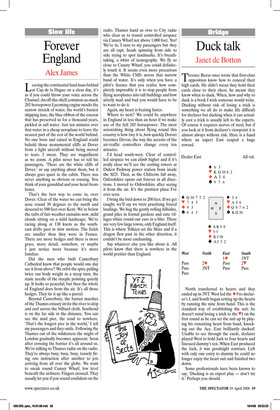Forever England
Alex James
Leaving the continental land mass behind at Cap de la Hague on a clear day, it’s as if you could throw your voice across the Channel. An off-the-shelf, common-as-muck 285 horsepower Lycoming engine mocks the narrow stretch of water, the world’s busiest shipping lane, the blue ribbon of the cocoon that has preserved us for a thousand years, pickled in salt water. Just ten minutes over that water in a cheap aeroplane to leave the nearest part of the rest of the world behind. No one born and raised in England could behold those monumental cliffs at Dover from a light aircraft without being moved to tears. I swear. They are magnificent as we zoom. A pilot never has to tell his passengers, ‘There are the white cliffs of Dover,’ or say anything about them, but it always goes quiet in the cabin. There was never anything so obvious or rousing. You think of your granddad and your heart beats faster.
That’s the best way to come in, over Dover. Clear of the water we can bring the nose round 30 degrees to the north and descend to 500 feet over Kent. We’re below the tufts of fair-weather cumulus now, mild clouds sitting on a mild landscape. We’re racing along at 130 knots as the southeast drifts past in slow motion. The fields are smaller than they were in France. There are more hedges and there is more grass, more detail, somehow, or maybe I just notice more because it’s more familiar.
Did the men who built Canterbury Cathedral know that people would one day see it from above? We orbit the spire pulling twice our body weight in a steep turn, the static needle of the steeple pointing quietly up. It looks so peaceful, but then the whole of England does from the air. It’s all those hedges. They tie it up like a parcel.
Beyond Canterbury, the barren marshes of the Thames estuary invite the river to drip and curl across the billiard cloth. Southend is on the far side in the distance. You can see the mad pier, the road to nowhere. ‘That’s the longest pier in the world,’ I tell my passengers and they smile. Following the Thames out of the wilderness the might of London gradually becomes apparent. Soon after crossing the barrier it’s all around us. We’re talking to Thames radar on the radio. They’re always busy, busy, busy, tensely firing one instruction after another to jets arriving from all over the globe. We want to sneak round Canary Wharf, low level beneath the airliners. Fingers crossed. They usually let you if you sound confident on the radio. Thames hand us over to City radar who clear us to transit controlled airspace via Canary Wharf not above 1,000 feet. Yes! We’re in. I turn to my passengers but they are all rapt, heads spinning from side to side trying to spot landmarks. It’s breathtaking, a whirr of iconography. We fly so close to Canary Wharf, you could definitely touch it. It seems even more precarious than the White Cliffs across that narrow band of water. It’s only when you have a pilot’s licence that you realise how completely impossible it is to stop people from flying aeroplanes into tall buildings and how utterly mad and bad you would have to be to want to do it.
Again, my heart is beating faster.
Where to next? We could be anywhere in England in less than an hour if we make use of the full 285 horsepower. The most astonishing thing about flying round this country is how tiny it is, how quickly Dorset becomes Devon, the way the accents of the air-traffic controllers change every ten minutes.
I’d head south-west. Clear of controlled airspace we can climb higher and if it’s really clear we’ll see the cooling towers at Didcot Parkway power station from inside the M25. Then, as the Chilterns fall away, Oxfordshire opens out forever in all directions. I moved to Oxfordshire after seeing it from the air. It’s the prettiest place I’ve ever seen.
I bring the bird down to 200 feet. If we get caught, we’ll say we were practising forced landings. We hug the gently rolling hillsides, grand piles in formal gardens and cute villages whizz round our ears in a blur. There are very few large towns, only England itself. This is where Tolkien set the Shire and if a dragon flew past in the other direction, it couldn’t be more enchanting.
Say whatever else you like about it. All pilots know that there is nowhere in the world prettier than England.


















































































 Previous page
Previous page